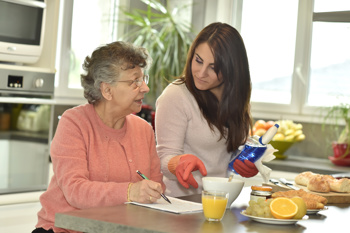
Handover in care homes
Your care home handover should include all actions that have been carried out during the previous shift, a summary of updates and concerns, and any recent accidents or health-related incidents. To be effective, the handover process requires clear, concise and relevant communication.
Why handovers in care homes are important
A study of handovers in care homes by King’s College London found that handovers fulfil important functions in addition to communicating about residents and care issues. These include:
- Matching skills to needs
- Teambuilding
- Staff training
- Addressing staff issues
- Promoting person-centred care
Good handover practice makes an important contribution to the overall standard of care in a home. Poor handover practice often leads to errors, accidents, and poor patient satisfaction.
In a recent extreme case, poor handover practice led to a 69 year old man dying in his care home after he choked on a sandwich prescribed by a carer. The carer was unaware that the man had been prescribed a ‘soft food’ diet. The inquest returned a conclusion of ‘unlawful killing.’
Good practice for handovers in care homes
Good practice for handovers will vary widely across different care homes due to variations in the number of residents and local circumstances.
Important factors to consider when determining what constitutes handover good practice include:
- The timing and length of handovers
- The choice between paper or electronic record systems
- The relative degree of participation of care assistants and nurses
- Whether or not staff should be paid for coming in before their shifts to facilitate handovers
Tips for successful handovers in care homes
Although the circumstances around each care home may vary, here are some valuable tips for successful handovers that apply universally:
Be precise
Handovers need be fast and efficient so the outgoing care worker can go home and the incoming care worker can get up to speed. The information needs to be conveyed in an accurate and concise manner.
Focus on the facts
Care workers should resist the temptation to give personal opinions based on feelings or assumptions. Only professional opinions backed by clear reasoning based on the facts should be included.
Start with the most important information
Important information must go first. Examples of such information could be residents with urgent concerns, upcoming medical tests, or recent emergencies. Incoming care workers need to know if there’s anyone high on the observation list.
Be compassionate
Bear in mind that other people may read the handover note. This could include the resident themselves or their family. When touching on sensitive topics, for example a person’s poor hygiene, be sensitive and constructive.
Avoid jargon
People who read the handover note may not be familiar with jargon or abbreviations. Misunderstands can lead to mistakes or delays. Auditors or inspectors may be confused by notes full of jargon.
Preserve confidentiality
Confidentiality is important to respect residents’ privacy and safeguard their personal details. Handovers should be conducted in quiet areas away from other residents. Only discuss confidential information with the appropriate people.
Ask questions
Incoming care workers should be encouraged to ask relevant questions to their outgoing colleagues. Don’t rely on guess work. Asking questions will ensure that they get all the important updates.
Put residents’ needs above staff needs
The timings of handovers should be managed to accommodate residents’ needs, not staff needs. Preferred bedtimes and getting-up times of residents should be taken into consideration when planning handover times. Residents should not be expected to alter their bedtimes because staff are conducting a handover.
Get staff involved
Encourage staff to contribute their own ideas about how handovers should be conducted. Giving staff an active role in planning and managing handovers will increase the quality of care provided. Additionally, increased staff involvement will build team cohesion, increase job satisfaction and boost retention.
Care home handover checklist
This checklist sets out the most common types of information that should be included in a handover:
- Resident’s identity
- Resident’s location
- Relevant background information
- Recent actions taken by staff
- Current and anticipated needs
- Medications taken or required
- Ongoing issues or concerns
- Recommendations for future actions
- Time frame for future tasks
Following this checklist will ensure that there are no communication issues that put your residents’ safety at risk. It will help you to make your handovers seamless in order that you can maintain a consistent, responsive level of care.

Care home handover template
Care home handover templates can be used to ensure there is a smooth transition when care workers change shift. By ensuring that all relevant information is communicated across shift changes, they ensure the continuity of safe and effective care. Templates are a convenient and effective way to reduce human error.
Benefits of care home handover templates
Handover templates benefit the residents by:
- Focusing the handover on the resident’s needs
- Standardising the recording of basic resident data to avoid duplication
- Reducing the risk of human error
- Encouraging a person-centred approach
- Contributing to positive outcomes in residents’ wellbeing and safety
Handover templates benefit the staff by:
- Reducing the repetition of information recording and transfer
- Making handovers more relevant
- Saving the time required for handovers
- Collecting information from various disciplines
- Maximising the time for personal contact with residents
Any care home handover template must be tailored to the specific needs of your care home. Your template should be customized to reflect the feedback from your staff regarding the information they need the most at handover. Changes should be made as required to incorporate new information and checks.
SBAR care home handover sheet template
One of the most established formats for a care handover sheet template is SBAR, which stands for situation, background, assessment, and recommendation.
A SBAR based template might look like this:
Details
Date:
Name of resident:
Name of duty manager:
Name of person providing handover:
Name of person receiving handover:
Situation
Current condition:
Recent actions:
Current medication:
Special notes:
Any other info:
Background
Relevant medical history:
Relevant personal needs:
Past medication requirements:
Family support:
Capacity:
Any other info:
Assessment
Current issues:
Current needs:
Anticipated needs:
Recommendation
Required future actions:
Required medication:
Any other info:

Improving care home handovers
Care home handovers should be regularly reviewed to ensure they accommodate the changing needs of both staff and residents.
The review process has six stages:
Prepare
Start with preliminary information-gathering.
- Talk to staff: How do they feel about the handover process? Are they sufficiently prepared after the handover? What problems are they facing?
- Talk to residents: What is their experience of the handover process? Do they know who is responsible for their care? Do they have concerns about the sharing of their information?
- Take a video: Video the entire handover. Keep the video in secure storage due to confidentiality issues.
- Review resident complaints: Identify any complains arising from handovers. Have there been any complaints about poor communication?
- Review incident reports: Have there been any incidents arising from handovers or missed information?
- Review time taken: Time handovers. Record any interruptions and why they happened.
Assess
Review the effectiveness of your current handover process.
- Accidents and errors: Calculate the number of communication-related incidents that occur per week.
- Resident experience: Make a note of any feedback from resident surveys concerning handovers.
- Staff experience: Do staff feel adequately prepared with the information they are given during handovers?
Discuss
Talk through potential approaches for improving handovers.
- Safety briefings: Dedicated safety briefings will focus awareness on residents’ risks to self or others.
- Location: Hold handovers in a location where the information to be shared is readily available.
- Making a stand: Asking people to stay standing during handovers can reduce irrelevant discussion and save time.
- Time to read: Ensure that enough time is allocated to staff to allow them to read the handover briefing.
- Standardised information: Making the format of the handover information consistent will help avoid information gaps.
- Highlight priorities: Identify the top five priority residents in terms of risk of self-harm, self-neglect, or harm to others.
- Clarify roles and responsibilities: Make sure there is no confusion amongst staff about who is doing what.
Plan
Define the steps you need to take to improve your handover process.
- Goals: Define what you want to achieve.
- Redesign: Map out your new handover process.
- Standard operating procedure: Create a flowchart to illustrate your new standard process.
Evaluate
Put your new handover process into action and measure the results.
- Collect data: How long did it take? Were there any incidents? What is the feedback from your staff?
- Analyse data: Did you achieve the desired improvements in terms of efficiency, effectiveness, and resident satisfaction?
- Further improvements: What are the opportunities for further improvement?
- Share success: Invite your staff and residents to celebrate what you’ve achieved together.
The advantage of electronic handovers
Electronic handover systems have been shown to enhance the quality of information exchanged. This increases staff productivity, enhances continuity of care, and minimises avoidable risks due to miscommunication. By way of contrast, physical handover systems are more error prone, more open to misinterpretation, and less secure.
The benefits of electronic handover systems are shared by care managers, care workers, residents and their families. The efficiency and accuracy they offer enhance all aspects of care and help providers meet regulatory requirements.
At Access, we have been providing software solutions to the care sector for over 30 years. We currently work with over 6,000 care homes and over 4,500 community agencies.
Access Care and Clinical is our clinical management software for care homes, enabling you to plan, record and monitor all aspects of your delivery of care. It offers an electronic handover process that is smooth, accurate and safe.
Key features include:
- Easy-to-use mobile app allowing you to record medication, observations, and activities at the resident’s side
- Single integrated platform to eliminate double data entry
- Monitoring key vitals including food/fluid intake, repositioning and weight
- In-depth reporting that can drill down to regions or individual homes
- Customisable forms and documents to suit your organisation
To find out more about the clinical management software we offer at Access, contact us here to discuss your needs or book a demo.

